Table of Contents

1. Introduction
Nautiluses are cephalopods (Greek for “head-foot” due to tentacles attaching to the head) that are closely related to the coleoids such as octopus, cuttlefish and squid [1]. Commonly referred to as the “living fossils”, nautiluses had originated and virtually unmodified over the last 450 million years [2]. These marine creatures have dominated the ancient oceans before the realm of fishes arose, and even before the first dinosaurs appeared. There were approximately 10,000 species in prehistoric times but only six extant species in the Nautilidae family remain as of today [1] [3]. The Chambered Nautilus (Nautilus pompilius) is of particular interest, being the largest and most prevalent nautilus known to exist!
Genus Nautilus
- Nautilus pompilius Linnaeus, 1758;
- Nautilus macromphalus Sowerby, 1849;
- Nautilus stenomphalus Sowerby, 1849;
- Nautilus belauensis Saunders, 1981
- Allonautilus scrobiculatus (Lightfoot, 1786);
- Allonautilus perforates (Conrad, 1847).
2. Interesting facts about this unique creature!
2.1. Evolutionary relationship with ammonites!
Nautiluses are often compared with ammonites due to numerous morphological similarities. In contrast to popular belief, ammonites and modern coleoids are more closely related as compared to the extant nautilus [4]. Nautiluses originated from the Ordovician period (approximately 450 million years ago) wheres ammonites first appeared during the Permian period (approximately 240 million years ago) [4]. Ammonites faced extinction after three catastrophic events during the Permian, Triassic and end of the Cretaceous, which coincided with that of dinosaurs in the Cretaceous-Palaeogene (K-Pg) event [5]. Their shells are index fossils for stratigraphy due to their easy identification, rapid evolution and being discovered on many types of marine sedimentary rocks with global geographic distribution [6]. Ammonites were believed to be petrified snakes and were fitted with carved heads to be sold to pilgrims during the medieval times [5].
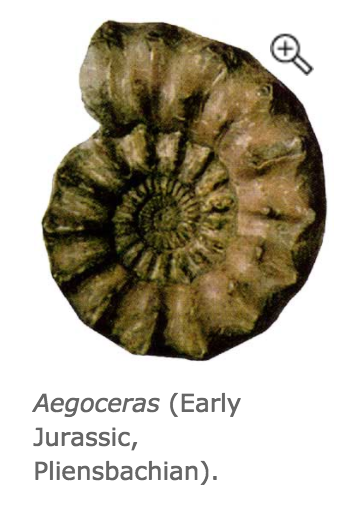 |
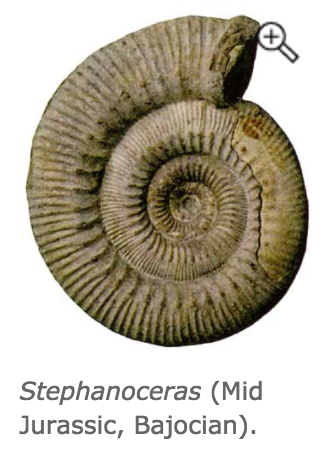 |
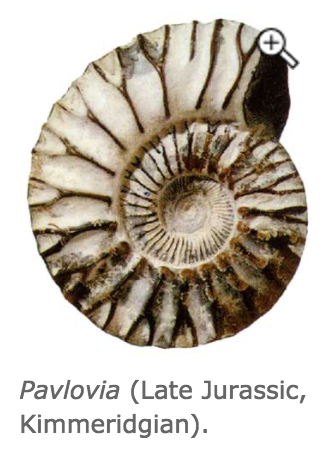 |
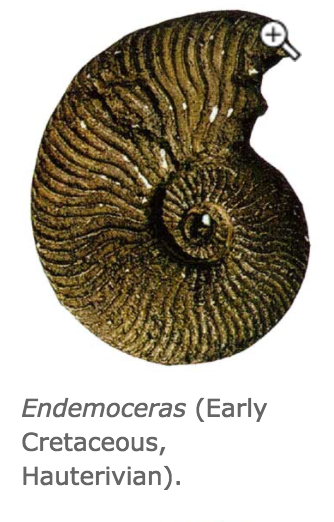 |
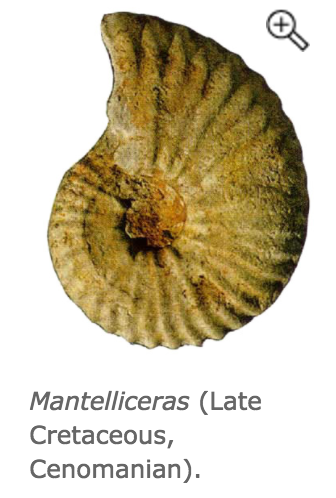 |
Table 1. Comparison of anatomical and physiological features between modern nautilus and ammonite fossils [8]
| Cephalopods |
Siphuncle |
Shell texture; inner chambers; sutures |
Protection mechanism |
Camouflage |
| Modern nautilus |
Runs straight through the centre of shell |
Smooth shell; 30 chambers; uniformly curved sutures |
No retraction of bodies into shell; leathery hood atop the head of shell |
Countershading |
| Ammonite fossils |
Ran along outer edge of the shell |
“Ribbed” shell; 26 chambers; undulated sutures |
Retraction of bodies into shell; flap called the aptychus close at the head of shell |
Colours unknown |
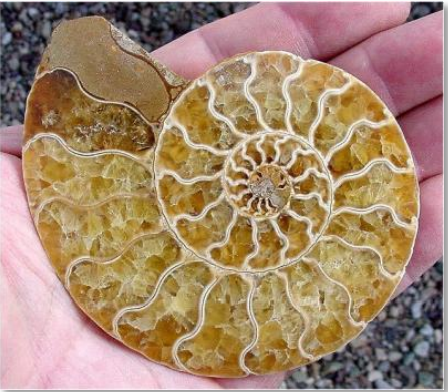
2.2. The nautilus shell is not a golden spiral!
Often associated with the golden spiral, the nautilus shell is in fact an equiangular spiral. The golden spiral ratio is a beautiful logarithm of 1.618:1 whereas the average ratio of nautilus shell is 1.33:1 [9].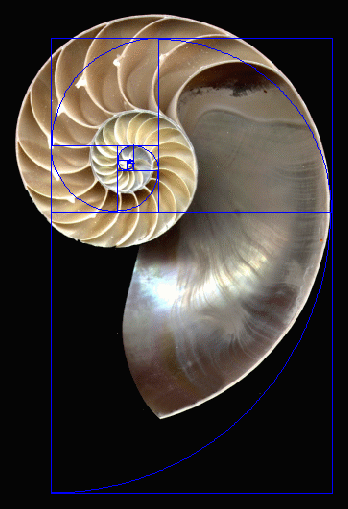
3. Geographic Distribution
3.1. Native distribution range
The occurrence of Nautilus pompilius subspecies exist in different regions - Nautilus pompilius pompilius covers the Andaman Sea east to Fiji and southern Japan south to the Great Barrier Reef whereas Nautilus pompilius suluensis is restricted to the Sulu Sea in southwestern Philippines [10].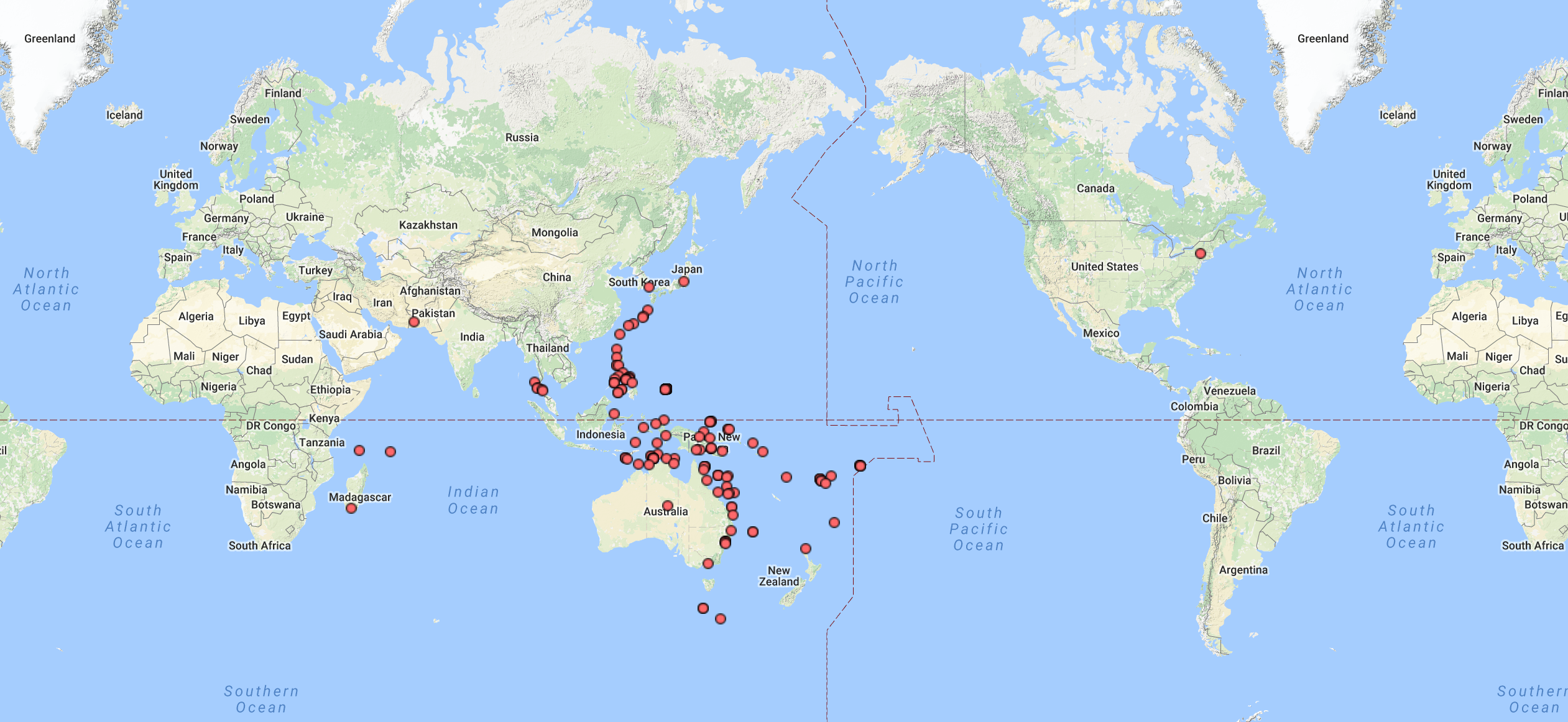
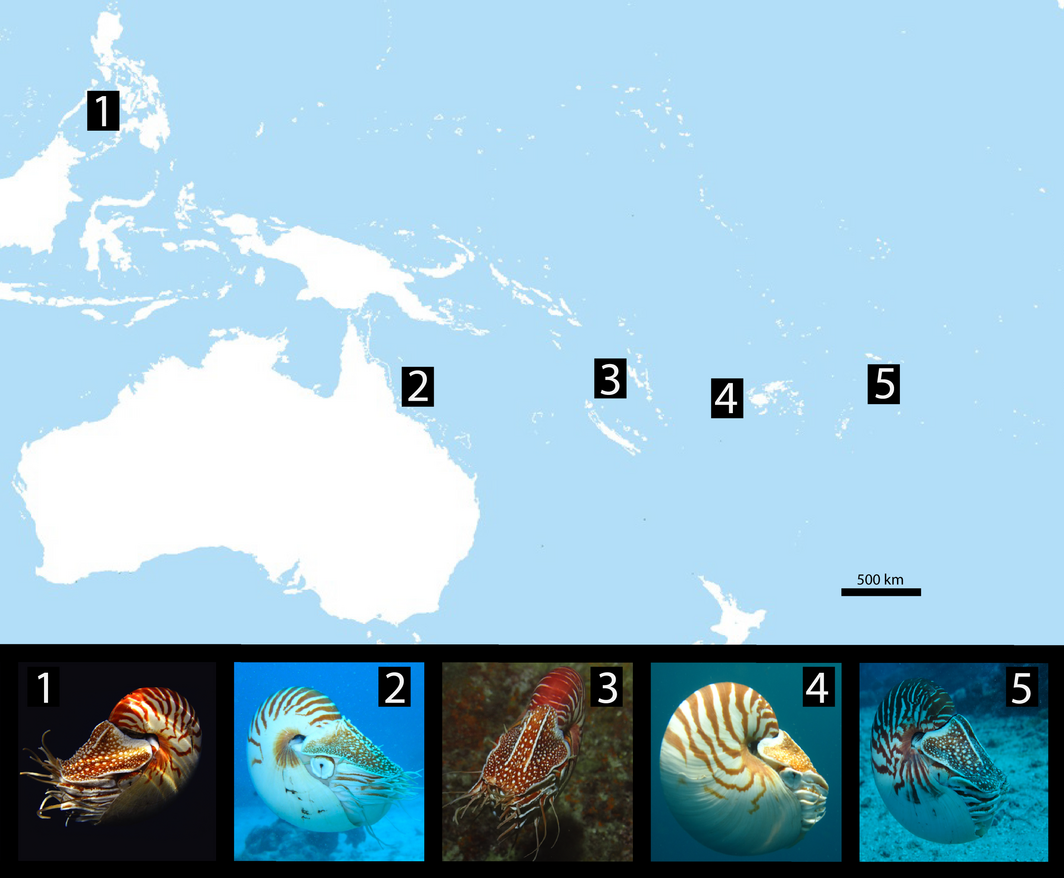
3.2. Singapore context
Few captive specimens currently reside in S.E.A. Aquarium [12]. However, no wild live specimens have been recorded in Singapore to date [13]. Only fragmented empty shell pieces have been retrieved until a complete nautilus shell was discovered on Pulau Semakau in a preliminary survey conducted in 2010 [14] [15]. The origin of this particular shell is undetermined yet. This finding raised questions on whether there could be a population near, if not in Singapore waters. Unfortunately, such a hypothesis may disappoint many due to (1) transportation by currents or (2) extensive involvement in ornamental shell trade and could be an accidental discovery!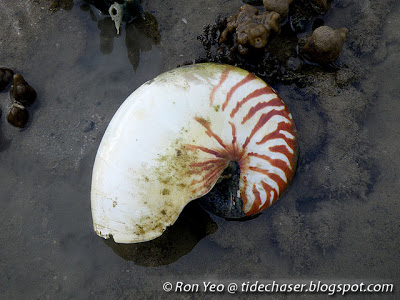 |
(Right) Complete postmortem shell of Nautilus pompilius discovered in Singapore. Photo credit: Ron Yeo. (Pending approval)
4. Threats & Conservation Status!
Identification of species within Nautilus is of great significance due to their vulnerability and susceptibility to commercial harvest in ornamental shell trade [16]. At present, there exists legislative protection for populations in Great Barrier Reef and local agreement with fishermen not to target populations in the Coral Sea (Australian regulatory authorities for additional protective measures - Marine Bioregional Planning of Coral Sea) [17]. Some countries such as Indonesia have banned their export since 1987. Furthermore, there is legal protection under Schedule 1, Appendix Part IV(B) Mollusca of Wildlife Protection Act, 1972.
In contrast, there is absence of such protective legislation in several regions such as the Philippines. They are not yet under the protection of U.S. Fish and Wildlife Service (USFWS), not evaluated for International Union for Conservation of Nature (IUCN) Red List of Threatened Species and not yet listed on Convention on International Trade in Endangered Species of Wild Fauna and Flora (CITES) [18]. Fortunately, there are petitions to review and list chambered nautiluses under Appendix II [19]. Long-term effects of Nautilus overfishing are unexplored but protective measures are key to conservation of this unique species.

5. Life History and Behaviour
5.1. Habitat
Chambered nautiluses occur at coral reef slopes of tropical and warm temperate waters in Indo-Pacific region. Being benthic bottom dwellers, they can dive to depths of 600-2000 feet [1]. Yet, there is a depth limit for these deep sea creatures where the deepest record was 2300 feet [20]. They are subjected to severe stress during rapid ascent and descent through the water column. An experiment conducted in 1980 resulted in the implosion of the ectosiphuncule, which is the weakest of all shell components, which occurred at depths of 2575 feet (hydrostatic pressure of 8.05MPa) [21] [22].5.2. Locomotion and Buoyancy
1. Diel vertical migrationHaving said that chambered nautiluses can ascend and descent through different oceanic zones, they undergo diurnal migration to deeper waters (600-2000 feet) to avoid predation and nocturnal migration up to coral reefs (300 feet) to hunt for prey [23]. To control positive, negative or neutral buoyancy while maintaining an upright position, the ratio of argon-nitrogen gas mixture and liquid saline solution in the inner chambers connected to ectosiphuncle is modified, and thus its weight, for diving [24].
2. Jet propulsion
Similar to other coleoids, chambered nautiluses move via jet propulsion. They exhibit a see-saw motion by alternately drawing water into its mantle cavity and blowing it out through the muscular, elastic siphon beneath the tentacles. This way, the forward, backward and sideways movements can be controlled [24].
Locomotion of the chambered nautilus. Video adapted from Youtube Channel: "The Chambered Nautilus" [25]

5.3. Reproduction, Growth and Sexual Maturity
Chambered nautiluses are gonochoristic organisms, indicating that the species have separate sexes. The male/female ratio is 8:1 and <10% are juveniles in unexploited populations [16]. Researchers have speculated that the male-biased sex ratio is (1) a reflection of the natural equilibrium of these populations and is the critical sex for its population growth or (2) due to sampling bias [27].Methods used to determine their sexes [23]:
1. Newly caught nautiluses which are not accustomed to captivity can be turned upside down. A visible horseshoe-shaped gland is found in females and will be brownish green in mature individuals. This method should only be performed by trained aquarists.
2. Locate the spadix (large modified tentacle made out of 4 tentacles) which should only be found on the left side in males.
Little is known about their reproductive means in the wild, and their mating behaviour is only observed in protected captivity [24]. Through internal fertilization, males transfer a sperm packet (i.e. spermatophore) via the spadix into the mantle cavity of females while holding onto their shell [2]. Each female lays 20 oblong eggs (largest amongst all cephalopods) and attaches the eggs to solid surfaces. The eggs are covered with membrane layers that form a protective covering. Development of the embryo lasts for 9-12 months before hatching [3]. Chambered nautiluses do not undergo larval stage and new hatchlings have four inner chambers. As they grow larger, septa are produced to seal off older chambers.
Table 2. Comparison of reproductive features between nautilus and coleoids
| Cephalopods |
Sexual maturity |
Reproductive strategy |
Lifetime reproductive rate |
| Nautilus |
Long; average of 10-15 years |
k selection [27]; long gestation periods and low offspring numbers |
Multiple times; once per year |
| Coleoids |
Short |
r selection [28]; short gestation periods and high offspring numbers |
Once |
5.4. Memory
Unlike modern cephalopods that have diverged from the primitive nautilus and evolved large brains for long term memory, chambered nautiluses have lack thereof brain structures. Nevertheless, a research study resembling Pavlov’s experiments with dogs demonstrated some evidence of a simple form of memory in chambered nautiluses [29] [30].Video adapted from Youtube Channel: "Simple minded nautilus reveals flash of memory"
5.5. Feeding
As opportunistic feeders, chambered nautiluses’ diet consists of high calcium food sources such as crustaceans and their molts, nematodes, echinoids, fishes to sustain normal shell growth [23]. They are also obligate scavengers, feeding on dead organisms (i.e. carrion) which is crucial for recycling of nutrients. At times, they even resort to cannibalism whereby cephalopod beaks and nautilus tentacles were found in their gut. Due to their poor vision, they locate prey via olfaction or specifically, chemotaxis [31]. They possess a pair of rhinopores to sample lateral currents for detecting chemical trails.5.6. Natural predators
Octopus, sharks, triggerfish, sea turtle prey on the chambered nautilus [1].6. Description
Anatomy & Physiology
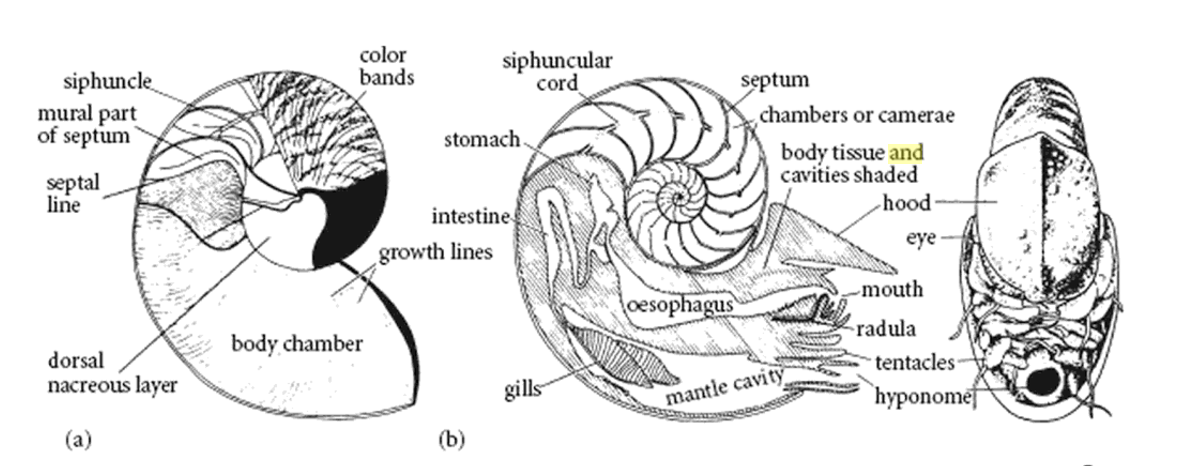
Internal compartmentalized chambers
The shell is underlined with compartmentalized chambers that are separated by septum walls. An individual can possess an average of 30 chambers by adulthood. Its entire body is contained within the outermost compartment, being the newest and largest [23]. Chambers are interconnected by an ectosiphuncule that is used for locomotion.
Spiral external shell and leathery hood
Nautiluses are the only cephalopods with an equiangular spiral external shell made of calcium carbonate produced by its mantle [23] [24]. Brown stripes radiate in an irregular pattern from umbilicus (approximately 5% of shell diameter) to venter [31]. Colouration (i.e. amount, hue, degree of coalescence of banding over the venter and band development near the umbilicus) is variable. An umbilical callus is secreted during the growth of second whorl, with rare exceptions of an open umbilicus. The leathery hood is situated above its body which is used for concealing itself at times of dangerous threats [23].
Functions of external shell [23]:
1. Protection: Nautilus withdraws its body into its shell completely and covers the opening with the leathery hood at times of threats.
2. Countershading: To avoid predators, the dark dorsal region of the shell blends in with the darkness of the sea when observed from above, while the light ventral region of the shell blends in with light penetration when observed from below.
Tentacles and feeding organs
Nautiluses possess more than 90 suckerless, retractable tentacles. These arm-like appendages have alternating grooves and ridges that are used to grip onto prey prior to delivering it to its beak-like jaw. The radula (file-like feeding structure) further shreds its prey before swallowing [1].
Table 3. Comparison of anatomical and physiological features between nautilus and coleoids
| Cephalopods |
Life Span |
Vision |
Chromatophores and ink sac |
Pairs of gills; and their attachment [32] |
| Nautilus |
Long; average of 20 years |
Poor vision due to simple, primitive eyes and absence of lenses |
Absent; thus poor camouflage |
Two; Single attachment at the origin and lie freely in the mantle cavity |
| Coleoids |
Short; average of 1-2 years |
Excellent vision |
Present |
One; Attachment along the body wall at one side |
7. Diagnosis
Nautilus pompilius have high morphological resemblance to other species in the Nautilidae family. Nevertheless, there are unique diagnostic features to differentiate each of the species.
Dichotomous key to two genera of the family Nautilidae
1a. Umbilicus small, or moderate, i.e. from 5-16% of shell diameter, whorl cross-section oval… Nautilus
1b. Umbilicus larger, approximately 20% of shell diameter, whorl cross-section quadrate… Allonautilus
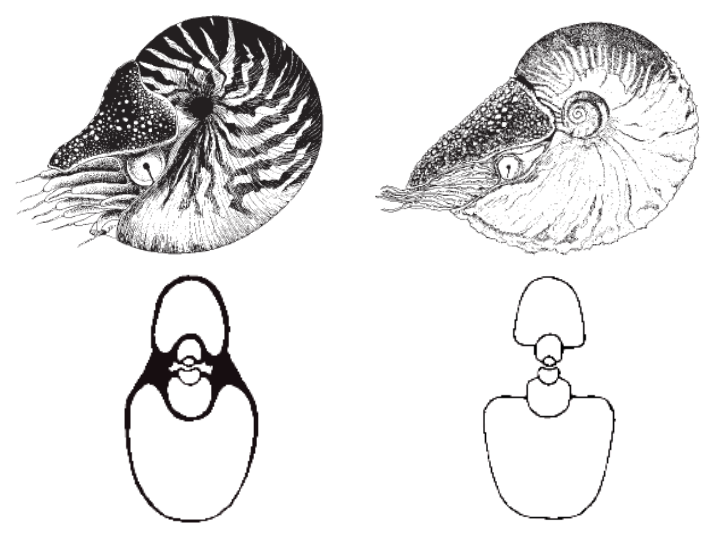
Table 4. Diagnostic features and geographic distribution of six extant species in the family Nautilidae. Due to lack of reliable sources, no images of each Nautilus species are illustrated below.
| Accepted scientific name |
Vernacular name(s) |
Brief description |
Size of shell diameter |
Geographical distribution |
| Nautilus pompilius |
Chambered nautilus; Emperor nautilus; Pearly nautilus [34] |
i. No inner shell coils visible. ii. Callus present on umbilicus. |
Maximum of 229 mm |
Refer here. |
| Nautilus macromphalus |
Bellybutton nautilus |
i. Inner shell coils visible. ii. Callus absent. |
Maximum of 160 mm |
Southwestern Pacific Ocean |
| Nautilus stenomphalus |
White-patch nautilus |
i. Reduced colouration in umbilicus region. ii. Hood covered by elevated papillae. iii.Callus absent. |
170 mm |
Great Barrier Reef of eastern Australia |
| Nautilus belauensis |
Pulau nautilus |
i. Large mature size. ii. Longitudinally growth lines with distinct concentrically lirate pattern on shell. iii.Wide central radular teeth. |
226 mm |
Pulau, Western Caroline Islands of North Pacific Ocean |
| Allonautilus scrobiculatus |
Crusty nautilus; Fuzzy nautilus |
i. Larger umbilicus. ii. Creases and encrusting layer on periostracum. iii. Different gills and male reproductive system from Nautilus species. |
180 mm |
Tropical western Pacific – Papua New Guinea, Manus Province, Bismark Archipelago, Milne Bay. Drift shells at Solomon Islands. |
| Allonautilus perforates |
N/A |
i. Shell similar to Allonautilus scrobiculatus |
Maximum of 180 mm |
Bali, Indonesia |
8. Etymology
The term "Nautilus" is coined in Greek Ναυτίλος (pronounced as nautilos) and refers to "paper nautilus" which literally means "sailor". The ancient Greeks thought that the webbed arms were used as sails [35].
9. Taxonomy and Systematics
9.1. Original description
The original description of Nautilus pompilius was retrieved from Biodiversity Heritage Library on 1 November 2016 [36]. The book collection is titled "Systema Naturae per regna tria naturae, secundum classes, ordines, genera, species, cum characteribus, differentiis, synonymis, locis. Editio decima, reformata. Laurentius Salvius: Holmiae. ii, 824 pp." Specifically, the description can be found on page 709:
9.2. Taxonavigation
The hierarchical ranks are referenced from Integrated Taxonomic Information System [37] and World Register of Marine Species (WoRMS) [38]. Ranks are not included in the classification because they do not provide meaningful information.| Animalia |
| Bilateria |
| Protostomia |
| Lophozoa |
| Mollusca |
| Cephalopoda Cuvier, 1797 |
| Nautiloidea Agassiz, 1847 |
| Nautilida Agassiz, 1847 |
| Nautilidae de Blainville, 1825 |
| Nautilus Linnaeus, 1758 |
| Nautilus pompilius |
| Nautilus pompilius pompilius Linnaeus, 1758 |
| Nautilus pompilius suluensis Habe and Okutani, 1988 |
9.3. Type Information
The type series of Nautilus pompilius comprises one specimen in the Linnean Society of London, four specimens in the University Museum in Uppsala and those figured by pre-Linnean authors such as Rumphius (1705) referenced in Linnaeus (1758) [39].Even though Linnaeus did not specifically mention any of the extant specimens in London and Uppsala, they were possibly known to him during the publication of the 10th edition of Systema Naturae (Linnaeus 1758).
Despite popular belief that the lectotype figured by Rumphius (1705) in his collection titled "D'Amboinsche Rariteitkamer" was designated by Linnaeus (1767), this assumption is invalid because no particular specimen was deemed to be the type specimen by Linnaeus himself. The specific description can be found on page 59-66 (http://www.biodiversitylibrary.org/item/127485#page/132/mode/2up). Subsequent lectotypifications of Rumphius' drawings are invalid due to the fact that three different specimens are illustrated [40].
Nevertheless, a lectotype from Linnaeus' collection can be designated. An alternative approach is to apply to International Commission on Zoological Nomenclature (ICZN) to disregard all preceding designations and assign a neotype of known origin based on molecular techniques given the quality of the specimens and uncertainty to its type status [39].
9.4. Phylogeny
Within the Class Cephalopoda, the evolutionary history of these "living fossils" dates back to the Ordovician period and has remained unchanged over the last 450 million years. Modern coleoids and extinct ammonites had diverged from their common ancestor (Plectronoceras) to form distinct lineages [4].Within the family Nautilidae, Nautilus and Allonautilus (previously known as N. scrobiculatus; genus renamed by Ward and Saunders, 1997) have high probabilities of having sister taxon relationship [41] [42]. However, there is no consensus of the phylogenetic classification of Nautilus to date. The taxonomic confusion (i.e. number of species in genus Nautilus and taxonomic status of N. pompilius) was due to poor recent fossil record and the proposed new species were originally collected and described from drift shells transported at extreme distances by surface currents (Refer to diagnosis for unique shell morphologies) [43].
Table 5. Examples of research analyses in attempts to resolve phylogenetic classification of N. pompilius
| Analysis methodologies |
Research authors, Year |
Independent lineages within N. pompilius? |
| Maximum likelihood, neighbor joining trees, fossil evidence |
Wray et al., 1995 |
No |
| Karotyping (18S rDNA) |
Bonnaud, Ozouf-Costaz & Boucher-Rodoni, 2004 [44] |
No |
| Simultaneous analysis, maximum parsimony, genetic distance estimation, population aggregation analysis |
Bonacum et al., 2011 |
Yes |
| Optimal nucleotide substitution model, Bayesian inference |
Vandepas et al., 2016 |
No |
Some researchers suggest that individuals from different populations may be morphotypes or subspecies, or even have phenotypic plasticity. Differences in morphological features without the creation of new species could have occurred due to environmental factors such as geographic boundaries and oceanographic conditions. The evidence of samples from different localities distributing amongst N.pompilius samples may indicate that there is no reproductive isolation and thus likelihood of gene flow amongst these populations is high [42].
Other studies have shown cryptic diversity under N. pompilius where there are potentially up to five distinct species. Long distance migration was unlikely due to physiological and depth constraints such as reef slope lifestyle and dispersal limitations [43]. As such, reproductive isolation amongst these populations could have occurred, leading to formation of new species. The fact that these populations are discovered in different geographic localities indicates the occurrence of migrations, though the process as to how these migrations came about is unclear. It has been suggested that events such as glacial ocean movements and large scale disturbances such as cyclones could have led to such migrations over geological time scale.
Based on the above-mentioned phylogenetic analyses (morphological and molecular data), N. stenomphalus, N. macromphalus, N. belauensis and N. pompilius from various geographic localities should fall under the same clade.

Phylogenetic reconstruction of Nautilus populations using N. scrobiculatus (now Allonautilus scrobiculatus) as outgroup; unordered characters;100 random addition heuristic searches in parsimony analyses. Image adapted from Wray et al., 1995.
10. Relevance to Humans
Art and Literature
- The famous poem “The Chambered Nautilus” was written by Oliver Wendell Holmes, where the original poem can be found on page 65 [45].
- A painting of "Chambered Nautilus" (1956) by Andrew Wyeth. A review of the art piece speculated its reference to the "The Chambered Nautilus" poem [46].
- Jewelry companies have designed pieces with reference to the exquisite inner chamber patterns of the nautilus shell [47].
Brand Names
- Nautilus Minerals: Canadian company to first launch deep sea mining campaign [48].
- U.S.S. Nautilus (launched in 1954): First nuclear-powered Jules Vern’s submarine in the world [49].
11. Glossary
| Benthic |
Ecological zone at the lowest level of a water body such as oceans, which includes the sediment and sub-surface layers. |
| Callus |
Thickened area of shell material that can cover the umbilicus (partly or completely). |
| Chemotaxis |
Movement of a motile organism in response to chemical stimuli. |
| Coalescence |
Two or more particles merge upon physical contact. |
| Cryptic diversity |
Phenomenon where individuals have identical morphology but belong to different species. |
| Diurnal |
During the day. |
| Equiangular |
Having equal angles. |
| Heuristic |
Trial and error. |
| Hyponome |
A tube or funnel in cephalopods where water is expelled from for jet propulsion. |
| Lectotype |
Physical specimen selected by a subsequent author from the syntypes (several specimens described in olden days) as type species. |
| Lirate |
Thread-like grooves |
| Morphotypes |
Individuals in a population (of the same species) distinguished by their morphology. |
| Oblong |
Rectangle with unequal sides. |
| Olfaction |
Sense of smell. |
| Outgroup |
Group of organisms not belonging to the group whose evolutionary relationships are being analysed. Such a group is used for comparison to assess characters of the in-groups. |
| Papillae |
White bumps on leathery hood |
| Paraphyletic |
Group of organisms that descended from common evolutionary ancestor or ancestral group, but not including all of the descendants. |
| Parsimony |
Simplest and best hypothesis that requires least evolutionary changes in phylogenetic tree reconstruction. |
| Periostracum |
Thin organic coating at outermost layer of shell |
| Phenotypic plasticity |
Ability of one genotype to produce more than one phenotypes when exposed to different environmental conditions. |
| Pilgrim |
A traveler on a physical journey towards a holy place. |
| Postmortem |
Dead form of an organism. |
| Rhinopores |
Receptors used for detecting odours. |
| Stratigraphy |
A branch in geology involved in studying rock layers and layering. |
| Umbilicus |
Depression in the centre of shell whorl |
| Undulated |
Wavy form or outline. |
| Unordered characters |
Multistate (more than two states) morphological characters that have equal costs in phylogenetic analyses using parsimony. |
| Uppsala |
Fourth largest city of Sweden. |
| Whorl |
Spiral pattern. |
12. References
[1] "Chambered Nautilus,” by George Grall. National Aquarium, n.d. URL: http://www.aqua.org/explore/animals/chambered-nautilus (Accessed on 1 November 2016).
[2] “Fascinating Facts About the Nautilus,” by Jennifer Kennedy. About Education, n.d. URL: http://marinelife.about.com/od/invertebrates/ss/9-Fascinating-Facts-About-Nautiluses.htm#showall (Accessed on 2 November 2016).
[3] “Chambered Facts About Nautiluses,” by Mark Mancini. Mental Floss, n.d. URL: http://mentalfloss.com/article/73200/10-chambered-facts-about-nautiluses (Accessed on 2 November 2016).
[4] Benton, M. & Harper, D. A. T., 2013. Introduction to Paleobiology and the Fossil Record. John Wiley & Sons, Inc.
[5] “Ammonite Fossils", by The Crystal Caves, n.d. URL: http://www.crystalcaves.com.au/infosheets/2%20Ammonite.pdf (Accessed on 1 November 2016).
[6] "Ammonites through time" by British Geological Survey. National Environment Research Council, n.d. URL: http://www.bgs.ac.uk/discoveringGeology/time/Fossilfocus/ammonite.html (Accessed on 18 November 2016).
[7] Weston, P., 1996. How to Read an Evolutionary Family Tree. Creation, 18(3): 52.
[8] “The Differences Between Nautilus and Ammonites,” by Brenton Shields. eHow, n.d. URL: http://www.ehow.com/info_8687704_differences-between-nautilus-ammonite.html (Accessed on 2 November 2016).
[9] “Is the Nautilus shell spiral a golden spiral?,” by Gary Meisner. The Golden Number, 8 February 2014. URL: http://www.goldennumber.net/nautilus-spiral-golden-ratio/ (Accessed on 9 November 2016).
[10] “Chambered Nautilus – Nautilus pompilius,” by Carnivora, 9 January 2012. URL: http://carnivoraforum.com/topic/9333593/1/ (Accessed on 2 November 2016).
[11] “Nautilus pompilius – Maps,” by Encyclopedia of Life, n.d. http://eol.org/pages/590944/maps (Accessed on 2 November 2016).
[12] “Explore S.E.A. Aquarium: Ocean Journey,” by Resorts World Sentosa, n.d. URL: http://www.rwsentosa.com/Homepage/Attractions/SEAAquarium (Accessed on 2 November 2016).
[13] “Cephalopods (Phyllum Mollusca: Class Cephalopoda) of Singapore: Order Nautilida,” by Ron Yeo. The Tide Chaser, 6 December 2012. URL: http://tidechaser.blogspot.sg/2012/12/cephalopoda-of-singapore.html (Accessed on 1 November 2016).
[14] "Project Semakau," by Lee Kong Chian Natural History Museum, n.d. URL: http://projectsemakau.rafflesmuseum.net/ (Accessed on 15 November 2016).
[15] Tan, S. K. & Yeo, R. K. H., 2010. The intertidal Molluscs of Pulau Semakau: Preliminary Results of "Project Semakau". Nature in Singapore, 3: 287-296.
[16] Valdivia, A., 2016. A Petition to List Chambered Nautilus (Nautilus pompilius) as Endangered or Threatened Species Under the Endangered Species Act. Center for Biological Diversity, 5-47.
[17] Williams, R. C., Newman, S. J. & Sinclair, W., 2012. DNA barcoding in Nautilus pompilius (Mollusca: Cephalooda): evolutionary divergence of an ancient species in modern times. Invertebrate Systematics, 26: 548-560. doi: 10.1071/IS12023
[18] “Pearly nautilus may get extra protection,” by K. S. Sudhi. The Hindu, 4 April 2016. URL:
http://www.thehindu.com/sci-tech/energy-and-environment/pearly-nautilus-may-get-extra-protection/article8426578.ece (Accessed on 9 November 2016).
[19] “Inclusion of the Family Nautilidae (Blainville, 1825) in Appendix II in accordance with Article II paragraph 2(a) of the Convention and satisfying Criterion B in Annex 2a of Resolution Conf. 9.24 (Rev. CoP16),” by Convention on International Trade in Endangered Species of Wild Fauna and Flora, 24 September – 5 October 2016. URL: https://www.fws.gov/international/cites/cop17/ussubmissions/chambered_nautilus_appendixII.pdf (Accessed on 9 November 2016).
[20] Dunstan, A. J., Ward, P. D. & Marshall, N. J., 2011. Vertical Distribution and Migration Patterns of Nautilus pompilius. PloS ONE, 6(2): e16311. doi: 10.1371/journal.pone.0016311
[21] Kanie, Y., Fukuda, Y., Nakayama, H., Seki, K. & Hattori, M., 1980. Implosion of living Nautilus under increased pressure. Paleobiology, 6(1): 44-47.
[22] Saunders, W. B. & Wehman, D. A. (1977). Shell strength of Nautilus as a depth limiting factor. Paleobiology, 3: 83-89.
[23] “Aquarium Science: Husbandry of the Nautilus: Aspects of its Biology, Behaviour, and Care,” by Adam Daw and Gregory J. Barord. Tropical Fish Magazine, June 2007. URL: http://www.tfhmagazine.com/details/articles/aquarium-science-husbandry-of-the-nautilus-aspects-of-its-biology-behavior-and-care.htm (Accessed on 2 November 2016).
[24] “Chambered Nautilus,” by Aquarium of the Pacific, n.d. URL: http://www.aquariumofpacific.org/onlinelearningcenter/species/chambered_nautilus (Accessed on 1 November 2016).
[25] “The Chambered Nautilus,” by cmcandles. YouTube Channel, 23 February 2009. URL: https://www.youtube.com/watch?time_continue=139&v=hcyzr3zJol4 (Accessed on 2 November 2016).
[26] “Nautilus – A shrimps view,” by David Remsen. Flickr, 31 July 1998. URL: https://www.flickr.com/photos/dremsen/2601013911 (Accessed on 1 November 2016).
[27] "Consideration of Proposals (17) for Amendment of Appendices I and II," by Convention on International Trade in Endangered Species of Wild Fauna and Flora, 24 September - 5 October 2016. URL: https://cites.org/sites/default/files/eng/cop/17/prop/FJ_US_Chambered_nautilus.pdf (Accessed on 15 November 2016).
[28] “Introduction to Cephalopods,” by Dr. James B. Wood. The Cephalopod Page, n.d. URL: http://www.thecephalopodpage.org/ (Accessed on 2 November 2016).
[29] "Simple minded nautilus reveals flash of memory," by Ewen Callaway. New Scientist, 2 June 2008. URL:
https://www.newscientist.com/article/dn14033-simple-minded-nautilus-reveals-flash-of-memory/ (Accessed on 9 November 2016).
[30] Crook, R. & Basil, J., 2008. A biphasic memory curve in the chambered nautilus, Nautilus pompilius L. (Cephalopoda: Nautiloidea). Journal of Experimental Biology, 211: 1992-1998. doi: 10.1242/jeb.018531
[31] “Nautilus pompilius – Details,” by Encyclopedia of Life, n.d. URL: http://eol.org/pages/590944/details(Accessed on 2 November 2016).
[32] “Cephalopod Gills,” by Richard E. Young and Michael Vecchione. Tree of Life Web Project, 2006. URL: http://tolweb.org/articles/?article_id=4200 (Accessed on 2 November 2016).
[33] Jereb, P. n.d. Chambered Nautiluses. FAO Species Catalogue for Fishery Purposes, 4(1): 50-55.
[34] “The Perils of the Pearly Nautilus,” by Dr. Neale Monks. The Cephalopod Page, n.d. URL: http://www.thecephalopodpage.org/nautcon.php(Accessed on 9 November 2016).
[35] “Nautilus,” by Online Etymology Dictionary, n.d. URL: __http://www.etymonline.com/index.php?term=nautilus__(Accessed on 9 November 2016).
[36] “"Systema Naturae per regna tria naturae, secundum classes, ordines, genera, species, cum characteribus, differentiis, synonymis, locis. Editio decima, reformata. Laurentius Salvius: Holmiae. ii, 824 pp.,” by Linnaeus, 1758. Biodiversity Heritage Library, 2007. URL: http://www.biodiversitylibrary.org/item/10277#page/731/mode/1up (Accessed on 1 November 2016).
[37] “Nautilus pompilius Linnaeus, 1758 – Taxonomic Serial No.: 557222,” by Integrated Taxonomic Information System, n.d. URL: https://www.itis.gov/servlet/SingleRpt/SingleRpt?search_topic=TSN&search_value=557222#null (Accessed on 1 November 2016).
[38] “WoRMS taxon tree – Nautilus pompilius Linnaeus, 1758,” by World Register of Marine Species (WoRMS), n.d. URL: http://www.marinespecies.org/aphia.php?p=browser&id=204549#ct (Accessed on 1 November 2016).
[39] Nikolaeva, S. V., 2015. A study of the type series of Nautilus pompilius Linnaeus, 1758 (Mollusca, Cephalopoda, Nautilida). Zootaxa, 3963(1): 55-73. doi: 10.11646/zootaxa.3963.1.4.
[40] Saunders, W. B. & Landman, N., 2009. Nautilus: The Biology and Paleobiology of a Living Fossil, Reprint with additions. Springer Science & Business Media, 1: 3-14.
[41] Wray, C. G., Landman, N. H., Saunders, W. B. & Bonacum, J., 1995. Genetic divergence and geographic diversification in Nautilus. Paleobiology, 21(2): 220-228.
[42] Vandepas, L. E., Dooley, F. D., Barord, G. J., Swalla, B. J. & Ward, P. D., 2016. A revisited phylogeography of Nautilus pompilius. Ecology and Evolution, 6(14): 4924-4935. doi: 10.1002/ece3.2248
[43] Bonacum, J., Landman, N. H., Mapes, R. H., White, M. M., White, A-J. & Irlam, J., 2011. Evolutionary radiation of present-day Nautilus and Allonautilus. American Malacological Bulletin, 29: 1-17. doi: 10.4003/006.029.0221
[44] Bonnaud, L., Ozouf-Costaz, C. & Boucher-Rodoni, R., 2004. A molecular and karyological approach to the taxonomy of Nautilus. Comptes Rendus Biologies, 327(2): 133-138.
[45] “The One Hoss Shay – The Chambered Nautilus and Other Poems, Gay and Grave,” by Oliver Wendell Holmes. The Riverside Press, Cambridge, 1900. URL: https://ia800709.us.archive.org/7/items/onehossshaychamb00holm/onehossshaychamb00holm.pdf (Accessed on 9 November 2016).
[46] "Examining Wyeth Anew: A review of 'Andrew Wyeth: Looking Beyond', in Hartford," by Sylviane Gold. The New York Times, 4 May 2012. URL: http://www.nytimes.com/2012/05/06/nyregion/a-review-of-andrew-wyeth-looking-beyond-in-hartford.html (Accessed on 15 November 2016).
[47] “Nautilus Shell,” by KA Gold Jewelry, n.d. URL: http://www.ka-gold-jewelry.com/p-articles/nautilus-shell.php (Accessed 2 November 2016).
[48] “Deep Sea Mining Campaign: A Project of the Ocean Foundation,” by Deep Sea Mining Out Of Our Depth, n.d. URL: http://www.deepseaminingoutofourdepth.org/tag/nautilus/ (Accessed on 9 November 2016).
[49] “Cold War: USS Nautilus (SSN-571),” by Kennedy Hickman. About Education, 6 September 2016. URL: http://militaryhistory.about.com/od/shipprofiles/p/ussnautilus.htm (Accessed 2 November 2016).
[50] "Chambered Nautilus, Nautilus pompilius," by MarineBio, n.d. URL:
http://marinebio.org/species.asp?id=168 (Accessed on 22 November 2016).